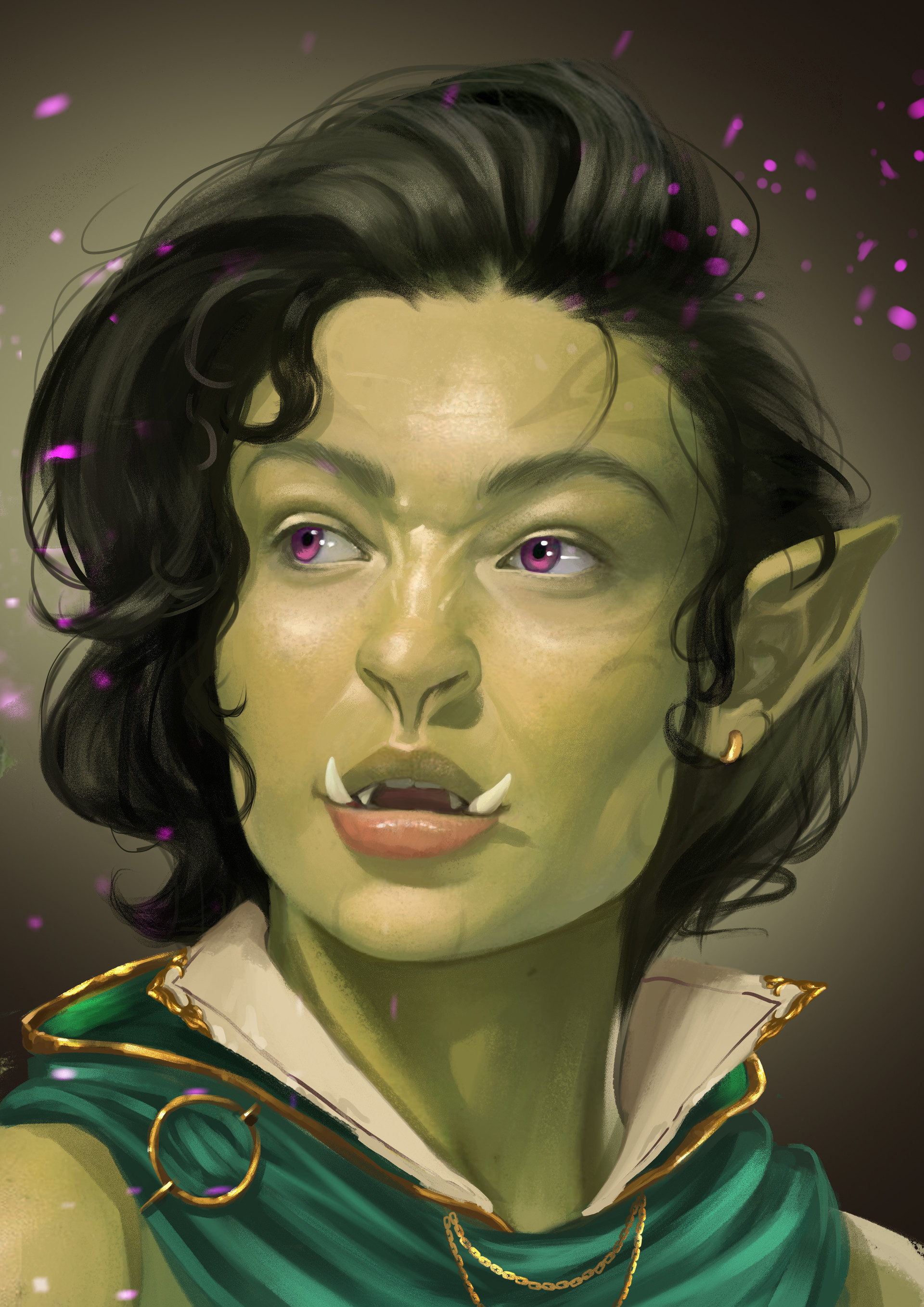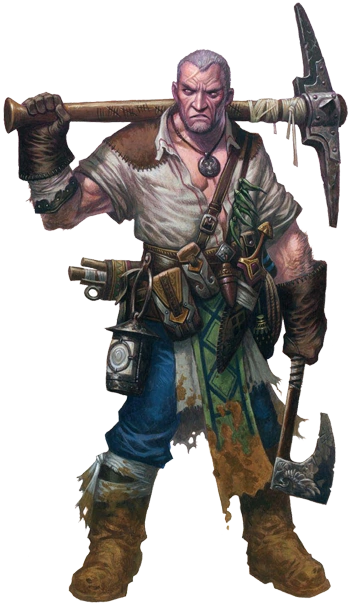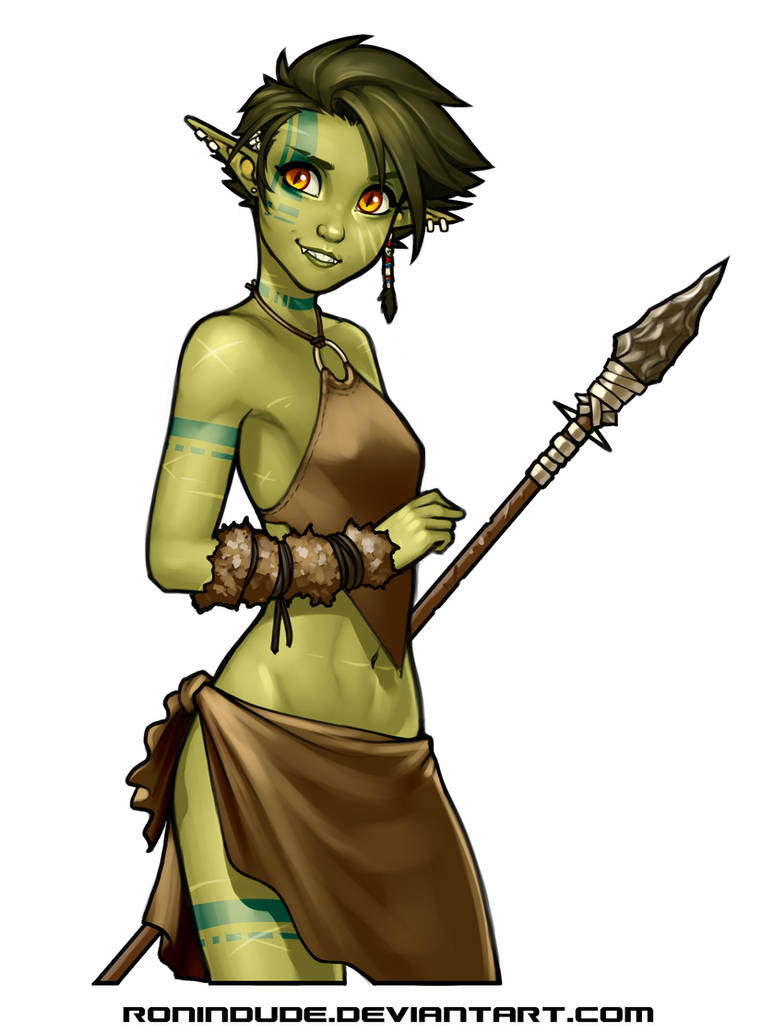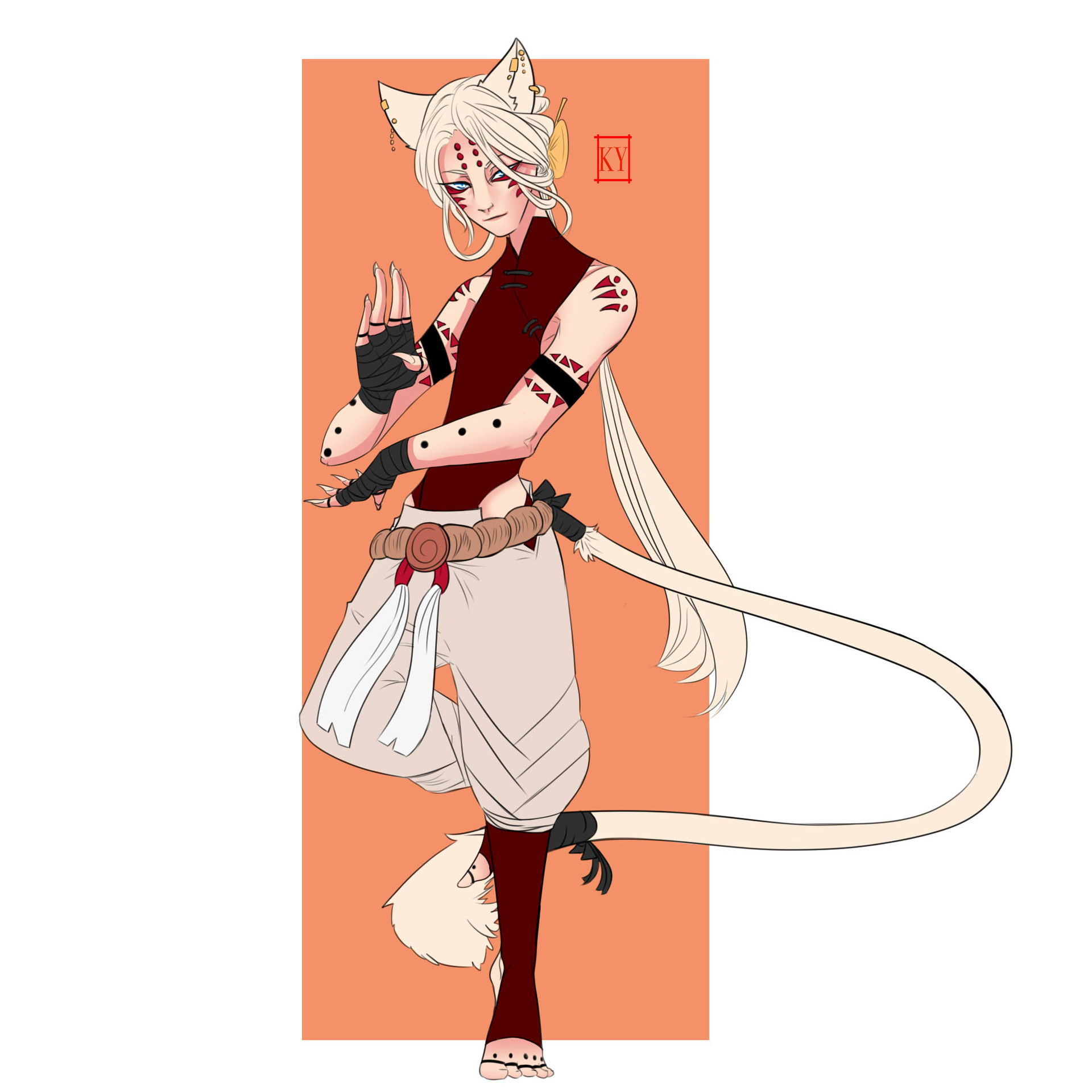


Half-Blood
ONE OF THE GUARDS OWETH HIRED FOR THIS LEG
of the journey was quite a peculiar sight - he had the tusks and grey skin of an orc, but the narrow frame and pointed ears of an elf! I later learned that he was of mixed parentage, and had been rejected by both communities. Poor fellow. Without a place to call home, he'd taken up work as a travelling mercenary, putting his elvish combat training and orcish endurance to good use. If I ever pass through the swamps of Myristad again, I'll be sure to see if he's looking for work.
– Garret Gamwich, A Journal of Journeys
Mixed Appearance
Half-bloods typically appear to be a blend of their parents' races. A half-orc-half-elf might have the greyish skin and tusks of an orc along with the slim build and pointed ears of an elf. A half-tiefling-half-dwarf might have the red skin and horns of a tiefling, but the stout build and large beard of a dwarf. In some cases, though, a half-blood will more strongly resemble only one of their parents' races; a half-tiefling-half-dwarf with more influence from his dwarvish side might appear to be an otherwise normal dwarf with an unusually ruddy complexion.
Of Two Cultures, or of None
Half-bloods often occupy unique positions in their societies. Among cultures more accepting of half-bloods, they might serve as diplomats, helping to negotiate disputes and agreements between their two cultures. Other cultures are not so accepting of half-bloods, and so many half-bloods find themselves adrift from the culture of their parents, forced to live as wanderers. Rarely does a half-blood feel completely at home in one of their parents' culture; differences in height, maturity, physique, and aptitude always seem to set them apart no matter where they go. Because of this, half-bloods of all ancestries tend to congregate, sharing the experience of alienation together.
Half-Blood Names
Half-bloods are typically named according to the traditions of one of their parents. Some half-bloods prefer to reject the culture of their parents, however, and pick new names that match the culture they end up living in. A half-orc-half-dragonborn who lives among humans might choose to pick a human name, for example.
Half-Blood Traits
A half-blood character's traits are in part determined by the races of their parents. Pick two of the races found in the Player's Handbook. These are the races of your parents, and your traits will partially depend on the traits of those races.
Ability Score Increase. One ability score of your choice increases by 2, and another ability score of your choice increases by 1. You must choose ability scores that are increased by one or both of your parents' races or subraces. For example, a half-orc-half-dwarf could choose any of the following ability scores for their increases: Strength, Constitution, or Wisdom.
Age. How quickly a half-blood matures, and how long they live, will be determined by their parents' races. Some half bloods age at a rate half way between those of their parents; others will age more akin to one parent than the other.
Alignment. Whether a half-blood is good or evil will depend heavily on the races of their parents, as well as the culture they were brought up in. Many half-bloods lean towards Chaos, as they often don't fit in the structures and conventions of society.
Size. The height and physique of a half-blood is often a blend of their parents', though they may lean more towards one parent or the other. You are the same size as your smallest parent.
Speed. You have the same walking speed as your slowest parent.
Languages. You speak Common, and two other languages of your choice. These languages are usually the ones spoken by your parents, but not always.
Additional Traits. You gain additional traits from your parents' races. The traits you gain from each race are detailed in the following lists.
If both of your parents had the Darkvision or Powerful Build traits, you also gain those traits.
Races from the Player's Handbook
Dragonborn
Breath Weapon. You can use your action to exhale destructive energy. Your draconic ancestry determines the size, shape, and damage type of the exhalation.
When you use your breath weapon, each creature in the area of the exhalation must make a saving throw, the type of which is determined by your draconic ancestry. The DC for this saving throw equals 8 + your Constitution modifier + your proficiency bonus. A creature takes 2d6 damage on a failed save, and half as much damage on a successful one. The damage increases to 3d6 at 6th level, 4d6 at 11th level, and 5d6 at 16th level.
After you use your breath weapon, you can't use it again until you complete a short or long rest.
Forceful Presence. You can use your understanding of creative diplomacy or intimidation to guide a conversation in your favor. When you make a Charisma (Intimidation or Persuasion) check, you can do so with advantage. Once you use this trait, you can't do so again until you finish a short or long rest.
Draconic Ancestry
| Dragon | Damage Type | Breath Weapon |
|---|---|---|
| Black | Acid | 5 by 30 ft. line (Dex. save) |
| Blue | Lightning | 5 by 30 ft. line (Dex. save) |
| Brass | Fire | 5 by 30 ft. line (Dex. save) |
| Bronze | Lightning | 5 by 30 ft. line (Dex. save) |
| Copper | Acid | 5 by 30 ft. line (Dex. save) |
| Gold | Fire | 15 ft. cone (Dex. save) |
| Green | Poison | 15 ft. cone (Con. save) |
| Red | Fire | 15 ft. cone (Dex. save) |
| Silver | Cold | 15 ft. cone (Con. save) |
| White | Cold | 15 ft. cone (Con. save) |
Dwarf
Dwarven Resilience. You have advantage on saving throws against poison, and you have resistance against poison damage.
Sturdy Build. Your speed is not reduced by wearing heavy armor.
Elf
Fey Ancestry. You have advantage on saving throws against being charmed, and magic can't put you to sleep.
Trance. Elves don't need to sleep. Instead, they meditate deeply, remaining semiconscious, for 4 hours a day. (The Common word for such meditation is "trance.") While meditating, you can dream after a fashion; such dreams are actually mental exercises that have become reflexive through years of practice. After resting in this way, you gain the same benefit that a human does from 8 hours of sleep.

Gnome
Gnome Cunning. When you are forced to make an Intelligence, Wisdom, or Charisma saving throw against magic, you can use your reaction to gain advantage on the roll. You must make this decision before the outcome of the roll is determined.
Halfling
Halfling Nimbleness. You can move through the space of any creature that is of a size larger than yours.
Lucky. When you roll a 1 on an attack roll, ability check, or saving throw, you can reroll the die and must use the new roll.
Human
Adaptable. An ability score of your choice increases by 1, so long as it has not already been increased by your race.
Skill Versatility. You gain proficiency in one skill of your choice.
Orc (PHB)
Relentless Endurance. When you are reduced to 0 hit points but not killed outright, you can drop to 1 hit point instead. You can't use this feature again until you finish a long rest.
Savage Attacks. When you score a critical hit with a melee weapon attack, you can roll one of the weapon's damage dice one additional time and add it to the extra damage of the critical hit.
Tiefling
Infernal Legacy. You know the thaumaturgy cantrip. Once you reach 3rd level, you can cast the hellish rebuke spell as a 2nd-level spell; you must finish a long rest in order to cast the spell again using this trait. Once you reach 5th level, you can also cast the darkness spell; you must finish a long rest in order to cast the spell again using this trait. Charisma is your spellcasting ability for these spells.
Non-Asmodean Tieflings
If you wish to be of a different Tiefling lineage, you can exchange your Infernal Legacy trait for a Legacy trait associated with a different Tiefling lineage, as detailed in Mordenkainen's Tome of Foes.
Races from Explorer's Guide to Wildemount
Aarakocra
Limited Fight. You have wings, though they are not as strong as your parent's. You have a flying speed of 30 feet, but you fall if you end your turn in the air and nothing else is holding you aloft. To use this flying speed, you can't be wearing medium or heavy armor.
Talons. Your talons are natural weapons, which you can use to make unarmed strikes. If you hit with them, you deal slashing damage equal to 1d4 + your Strength modifier, instead of the bludgeoning damage normal for an unarmed strike.
Genasi (Air)
Mingle with the Wind. You can cast the levitate spell once with this trait, requiring no material components, and you regain the ability to cast it this way when you finish a long rest. Constitution is your spellcasting ability for this spell.
Unending Breath. You can hold your breath indefinitely while you're not incapacitated.
Genasi (Earth)
Earth Walk. You can move across difficult terrain made of earth or stone without expending extra movement.
Merge with Stone. You can cast the pass without trace spell once with this trait, requiring no material components, and you regain the ability to cast it this way when you finish a long rest. Constitution is your spellcasting ability for this spell.
Genasi (Fire)
Fire Resistance. You have resistance to fire damage.
Reach to the Blaze. You know the produce flame cantrip. Once you reach 3rd level, you can cast the burning hands spell once with this trait as a 1st-level spell, and you regain the ability to cast it this way when you finish a long rest. Constitution is your spellcasting ability for these spells.
Genasi (Water)
Amphibious. You can breathe air and water.
Call to the Wave. You know the shape water cantrip. When you reach 3rd level, you can cast the create or destroy water spell as a 2nd-level spell once with this trait, and you regain the ability to cast it this way when you finish a long rest. Constitution is your spellcasting ability for these spells.
Swim. You have a swimming speed of 30 feet.
Tortle
Natural Armor. Due to your shell and the shape of your body, you are ill-suited to wearing armor. Your shell provides ample protection, however; it gives you a base AC of 16 (your Dexterity modifier doesn't affect this number). You gain no benefit from wearing armor, but if you are using a shield, you can apply the shield's bonus as normal.
Races from Mystic Oddysey of Theros
Centaur
Charge. If you move at least 30 feet straight toward a target and then hit it with a melee weapon attack on the same turn, you can immediately follow that attack with a bonus action, making one attack against the target with your hooves.
Hooves. Your hooves are natural melee weapons, which you can use to make unarmed strikes. If you hit with them, you deal bludgeoning damage equal to 1d4 + your Strength modifier, instead of the bludgeoning damage normal for an unarmed strike.
Leonin
Claws. Your claws are natural weapons, which you can use to make unarmed strikes. If you hit with them, you can deal slashing damage equal to 1d4 + your Strength modifier, instead of the bludgeoning damage normal for an unarmed strike.
Daunting Roar. As a bonus action, you can let out an especially menacing roar. Creatures of your choice within 10 feet of you that can hear you must succeed on a Wisdom saving throw or become frightened of you until the end of your next turn. The DC of the save equals 8 + your proficiency bonus + your Constitution modifier. Once you use this trait, you can't use it again until you finish a short or long rest.
Minotaur
Hammering Horns. Immediately after you hit a creature with a melee attack as part of the Attack action on your turn, you can use a bonus action to attempt to shove that target with your horns. The target must be no more than one size larger than you and within 5 feet of you. Unless it succeeds on a Strength saving throw against a DC equal to 8 + your proficiency bonus + your Strength modifier, you push it up to 10 feet away from you.
Horns. Your horns are natural melee weapons, which you can use to make unarmed strikes. If you hit with them, you deal piercing damage equal to 1d6 + your Strength modifier, instead of the bludgeoning damage normal for an unarmed strike.
Satyr
Ram. You can use your head and horns to make unarmed strikes. If you hit with them, you deal bludgeoning damage equal to 1d4 + your Strength modifier.
Reveler. You have proficiency in the Performance and Persuasion skills, and you have proficiency with one musical instrument of your choice.
Races from Mordenkainen's Tome of Foes
Gith
Gith Psionics. You know the mage hand cantrip, and the hand is invisible when you cast the cantrip with this trait.
Mental Discipline. When you make a saving throw against the charmed or frightened conditions, you can use your reaction to grant yourself advantage on the roll. You must make this decision before the outcome of the roll is determined.
Races from Volo's Guide to Monsters
Aasimar
Celestial Resistance. You have resistance to necrotic damage and radiant damage.
Healing Hands. As an action, you can touch a creature and cause it to regain a number of hit points equal to your level. Once you use this trait, you can't use it again until you finish a long rest.

Bugbear
Long-Limbed. When you make a melee attack on your turn, your reach for it is 5 feet greater than normal.
Firbolg
Firbolg Magic. You can cast detect magic and disguise self with this trait, using Wisdom as your spellcasting ability for them. Once you cast either spell, you can't cast it again with this trait until you finish a short or long rest. When you use this version of disguise self, you can seem up to 3 feet shorter than normal, allowing you to more easily blend in with humans and elves.
Speech of Beast and Leaf. You have the ability to communicate in a limited manner with beasts and plants. They can understand the meaning of your words, though you have no special ability to understand them in return. You have advantage on all Charisma checks you make to influence them.
Goblin
Nimble Escape. You can take the Disengage or Hide action as a bonus action on each of your turns.
Goliath
Mountain Born. You're acclimated to high altitude, including elevations above 20,000 feet. You're also naturally adapted to cold climates, as described in chapter 5 of the Dungeon Master's Guide.
Stone's Endurance. You can focus yourself to occasionally shrug off injury. When you take damage, you can use your reaction to roll a d12. Add your Constitution modifier to the number rolled, and reduce the damage by that total. After you use this trait, you can't use it again until you finish a short or long rest.
Hobgoblin
Martial Training. You are proficient with two martial weapons of your choice and with light armor.
Saving Face. Hobgoblins are careful not to show weakness in front of their allies, for fear of losing status. If you miss with an attack roll or fail an ability check or a saving throw, you can gain a bonus to the roll equal to the number of allies you can see within 30 feet of you (maximum bonus of +5). Once you use this trait, you can't use it again until you finish a short or long rest.
Kenku
Kenku Training. You are proficient in your choice of two of the following skills: Acrobatics, Deception, Stealth, and Sleight of Hand.
Mimicry. You can mimic sounds you have heard, including voices. A creature that hears the sounds can tell they are imitations with a successful Wisdom (Insight) check opposed by your Charisma (Deception) check.
Kobold
Grovel, Cower, and Beg. As an action on your turn, you can cower pathetically to distract nearby foes. Until the end of your next turn, your allies gain advantage on attack rolls against enemies within 10 feet of you that you can see. Once you use this trait, you can't use it again until you finish a short or long rest.
Sneaky. You are proficient in the Stealth skill.
Lizardfolk
Bite. Your fanged maw is a natural weapon, which you can use to make unarmed strikes. If you hit with it, you deal piercing damage equal to 1d6 + your Strength modifier, instead of the bludgeoning damage normal for an unarmed strike.
Natural Armor. You have tough, scaly skin. When you aren't wearing armor, your AC is 13 + your Dexterity modifier. You can use your natural armor to determine your AC if the armor you wear would leave you with a lower AC. A shield's benefits apply as normal while you use your natural armor.
Orc (VGM)
Aggressive. As a bonus action, you can move up to your movement speed toward a hostile creature you can see or hear. You must end this move closer to the enemy than you started.
Menacing. You are proficient in the Intimidation skill.
Tabaxi
Cat's Claws. Because of your claws, you have a climbing speed of 20 feet. In addition, your claws are natural weapons, which you can use to make unarmed strikes. If you hit with them, you deal slashing damage equal to 1d4 + your Strength modifier, instead of the bludgeoning damage normal for an unarmed strike.
Feline Agility. Your reflexes and agility allow you to move with a burst of speed. When you move on your turn in combat, you can double your speed until the end of the turn. Once you use this trait, you can't use it again until you move 0 feet on one of your turns.
Triton
Amphibious. You can breathe air and water.
Guardians of the Depths. Adapted to even the most extreme ocean depths, you have resistance to cold damage, and you ignore any of the drawbacks caused by a deep, underwater environment.
Swim Speed. You have a swimming speed of 30 feet.
Yuan-Ti
Innate Spellcasting. You know the poison spray cantrip.
Poison Resistance. You have advantage on saving throws against poison, and you have resistance against poison damage.
Racial Feats & Magic Items
Half-bloods count as their parents' races when choosing feats and attuning to magic items, but not their subraces. For example, a half-dwarf-half-elf could take the Elven Accuracy feat, but not Drow High Magic. Similarly, the same half-dwarf-half-elf could attune to a magic sword that can only be attuned to by elves, but not a cursed artifact of Lolth that can only be attuned to by drow.
Credits
- Half-Blood player race by /u/Enraric
- Aru, Half-orc Mage art by Caio Santos
- Clegg Zincher art by Paizo
- Half-Orc Girl art by RoninDude
- Half-Tabaxi D&D art by Brenna Dolce
- Racial traits by WotC, with some tweaking by /u/Enraric.
This document is unofficial Fan Content permitted under the Fan Content Policy. Not approved/endorsed by Wizards. Portions of the materials used are property of Wizards of the Coast. ©Wizards of the Coast LLC.
